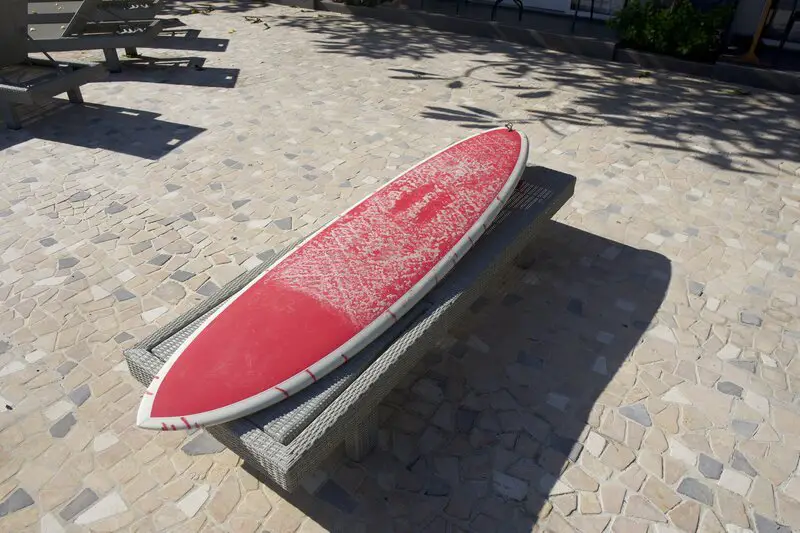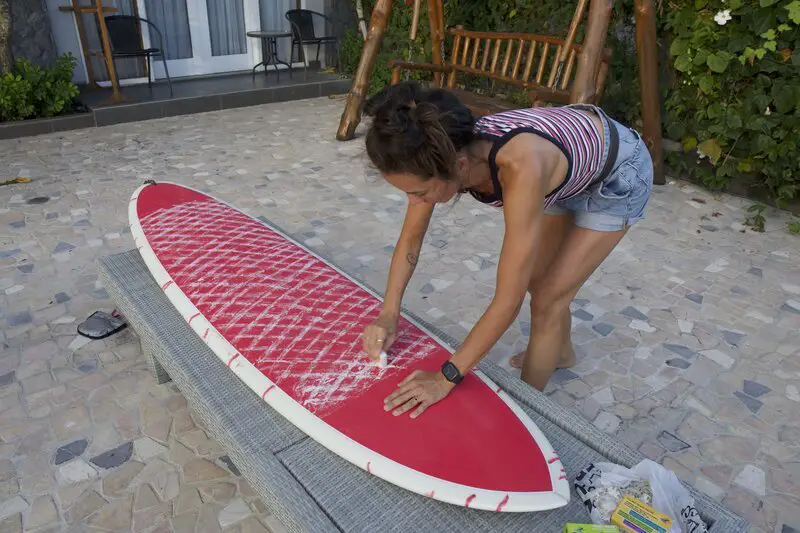Little feels as exhilarating as popping up on a freshly waxed surfboard and enjoying the grip that it offers as you carve along a wave. This moment of freedom isn’t quite the same if you slip on a back turn or try to hang 10 and eat foam instead. Knowing how to wax a surfboard can be the make or break of an epic surf session.
However, not many people know the basic steps of waxing a new or old surfboard. Making small mistakes like using the wrong wax or not including a base coat can make waxing your surfboard a fruitless effort.
Here’s a guide on the best way to apply surf wax to your board, and the answer to a few questions surrounding the job.
* Just to let you know that this article may contain affiliate links. If you click on them we might receive a small commission, at no extra cost to you.
Contents
Why Do Surfers Wax Surfboards?
If you’re new to surfing, then you may be wondering why you wax a surfboard in the first place! Surf wax has the clearly defined job of keeping surfers on their board and reducing the risk of slipping when paddling out or catching a wave.
Most surfers will give a quick rub of wax before each surfing session, or run a wax comb through the globules of stickiness to rough it up a bit. Over time, surf wax starts to lose its grip and stickinesss because of melting, sand, and becoming generally tacky.
Are you a beginner surfer and looking for the perfect board? Start your research here!

A surfboard covered in old, tired wax
What Do You Need For Waxing A Surfboard?
If you want to do a proper job of waxing your board, then there are a few items that you need to have readily available. We encourage you to use environmentally-friendly products that are free from animal cruelty and don’t cause damage to our beautiful oceans.
- An old plastic bag to collect the old wax that you wipe off of the board
- A spot in the direct sun
- A slightly damp cloth or old rag to wipe down the board
- Basecoat surf wax (get your basecoat here)
- Topcoat surf wax that is the correct temperature for your local waters (get your topcoat here)
- Wax comb with a flat side (get yours wax comb here)
There’s also a funky tool called Pickle wax remover if you’re feeling adventurous.
Choosing Your Surfboard Wax
The quality of your surf wax will have a big impact on the effectiveness of your wax job. Having a basecoat is one of the most important steps in doing the exercise correctly. The purpose of the basecoat is to create bumps for the stickier, topcoat to grip.
Speaking of the topcoat, the wax that you choose will largely depend on the temperature of the water that you’re surfing in. Most wax sticks are sold in a choice of tropical, warm, cool, and cold water – so do your research properly!
Read more about the best wax for surfboards in various conditions over here.
Where Should I Apply Surf Wax?
Different size boards have different focus areas for wax. If you surf a performance board, then you’ll want to focus on the area where your feet and chest go. If you surf a longboard, then you’ll want to cover more of the surface area from the nose to the tail so that you can dance along the surface without slipping off.
How To Wax A Surfboard
There are two main techniques that are used for waxing surfboards, and we like to combine them. If you’re waxing a new board, then you don’t need to worry about the first couple of steps – but keep them in mind for when you need to do the job again.
1. Put Your Board In The Sun
The first step is to remove the old, clunky wax from your surfboard. This is far easier to do when the wax is slightly melted and scrapes off easily. Put your surfboard in a safe place in direct sunlight for approximately 30 minutes. Depending on the strength of the sun, you may need to want to increase or decrease this time frame.
If you don’t live in a sunny climate, or you are waxing your surfboard before the sun comes out in full force, then you can use a hairdryer to melt the wax. Just be careful to keep a comfortable distance between the wax and hairdryer, and continually test the state of stickiness.

Placing the board in a safe, sunny spot
2. Scrape Away The Old Wax
Now that the wax has melted, you can use the flat end of your wax comb to scrape it off the board. Make sure that you have your plastic bag handy to collect the discarded wax, as it can get quite messy.
This feeling is low-key a guilty indulgence and actually feels far more gratifying than you’d think. With the wax soft from the heat, it slides right off of the board, leaving a beautiful, clean surface underneath.

Use the wax comb to remove the old wax
3. Clean The Board
There may be a little bit of wax leftover or some sticky areas that are particularly stubborn. One way to get rid of this excess wax is to loosen it with flour or wax remover.
We simply use an old rag that has been slightly dampened to wipe down the board. This removes all of the remaining muck and gives us a very rare view of a slick deck.

Clean board with no wax
4. Apply Basecoat Surf Wax In Crosshatch Style
Soak up every moment that you have with your clean board because you’re about to get it waxed up! First, apply the basecoat in a crosshatch style.
Mark out the area of the board that you want to wax and begin by drawing parallel, diagonal lines across the surface. Once you’re happy that you’ve done a good job, you can begin doing the same in the opposite direction. The result should be a neatly blocked area in a crosshatch style.
5. Apply Sticky Top Coat In Circles
Once you’ve got a neat framework of crosshatch basecoat, it’s time to apply the topcoat. We recommend doing this in small circles, filling in the gaps between the crosshatch squares. You’ll find that you end up using a bit more wax with the topcoat than you did with the base coat.
Once you’ve finished applying the topcoat, you can take a step back and take a good, hard look at the great job that you did.

Applying the topcoat of wax
Keep in mind that some people prefer to use other methods of applying surf wax. While we like to combine crosshatch and circular rubbing, others apply wax randomly, in horizontal patterns, and vertical patterns. None of these methods is wrong, so you just need to figure out what works for you – just don’t neglect the base coat!
Top Tips For Waxing Surfboards
Waxing a surfboard isn’t a tricky job, it just requires a fair bit of elbow grease. Even so, there are a few tips to make it even easier.
- Waxing surfboards should be done in the shade to avoid the wax from heating up, melting, and smearing
- Apply the wax gently to avoid the wax from smearing
- Some people like to use the razor edge of the comb across the board deck once the job is complete in order to roughen things up a little bit more
- Take the leash and fins off beforehand if they are likely to get in the way

Well-waxed surfboard
Alternatives To A Waxed Surfboard
If you’re a surfer, then you probably find great comfort in the smell of sunscreen, neoprene, ocean water, and, of course, surf wax. However, there are alternatives to waxing surfboards for stickiness, and here are a few of them.
- Full deck traction pad that covers the whole board – just make sure not to surf topless or you’ll walk out of the water with a major chafe
- Surfboard deck grip that is temperature independent without the risk of melting or leaving residue
- DIY traction non-slip grip mat trimmable sheet to customize the shape and size of your grip
Happy Shredding!
All that’s left to do is test your waxing skills in the water.
The more that you wax a surfboard, the more familiar that you’ll become with the techniques. If you have any other top tips to share, then we’d love to hear them, give them a try and add them to our blog!
If you’re a digital nomad looking for the best surfing destinations, read our blog here.
Generated with Pin Generator







